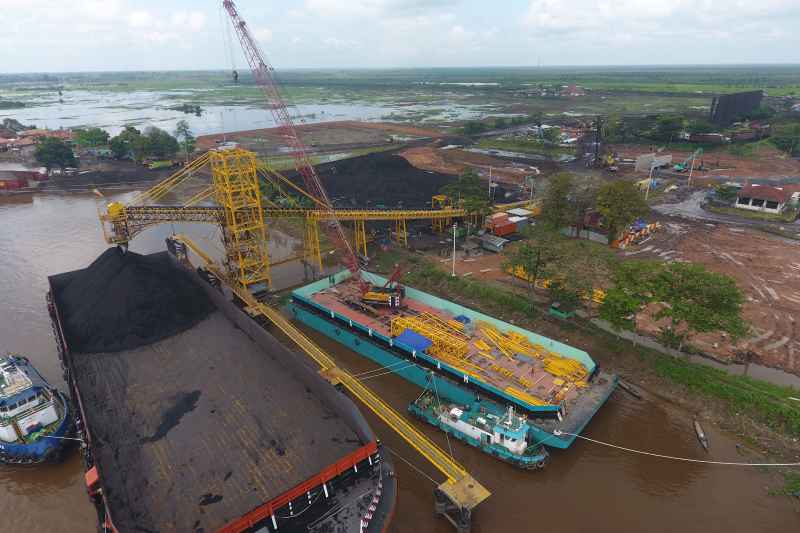Titan Infra Sejahtera's Mining Transportation Infrastructure in South Sumatra
By: Admin01 | Edited by: Admin01
Wednesday, 23 April 2025, 2:18 PM
 Titan Infra Sejahtera's Mining Transportation Infrastructure in South Sumatra
Titan Infra Sejahtera's Mining Transportation Infrastructure in South Sumatra
 Titan Infra Sejahtera's Mining Transportation Infrastructure in South Sumatra
Titan Infra Sejahtera's Mining Transportation Infrastructure in South Sumatra
PT Titan Infra Sejahtera (TIS), a provider of mining infrastructure services in South Sumatra, is optimistic about the growth of the coal industry in the region and its commitment to supporting sustainable and environmentally friendly mining operations. With two key subsidiaries—PT Servo Lintas Raya (SLR) and PT Swarnadwipa Dermaga Jaya (SDJ)—TIS plays a pivotal role in coal logistics within Indonesia's second-largest coal-producing strategic area.
Established and fully operational since 2017, Titan Infra Sejahtera controls two crucial assets: a 118 km hauling road operated by SLR and a dedicated coal port on the Musi River managed by SDJ. These two infrastructures serve as vital links between inland South Sumatra's coal mines and the global market. Through its IPO, the company hopes to attract investors who are concerned about environmental issues, given that TIS's core business focuses on supporting infrastructure—not direct mining activities.
"We do not own coal mines. Our business is purely infrastructure, so the environmental impact we generate is more controlled," emphasized Victor B Tanuadji, President Director of SLR and SDJ, during a press conference in Palembang on Monday, December 16, 2024. Victor added that this business model aligns with the global trend promoting sustainable mining practices.
TIS's confidence in the IPO prospects is underpinned by its solid financial performance. In 2023, the company recorded an EBITDA (earnings before interest, taxes, depreciation, and amortization) of US$100 million. This figure is projected to increase in 2024, in line with the surge in coal volume transported through TIS's infrastructure.
"This year, the volume of coal passing through SLR's hauling road and shipped by SDJ reached 21 million tons, a 15% increase from 18 million tons in 2023. Next year, we are targeting 27 million tons," explained Suryo Suwignjo, President Commissioner of PT Titan Infra Sejahtera. This increase is partly due to the addition of PT Bukit Asam Tbk (PTBA), one of Indonesia's largest coal producers, as a new client of TIS in 2024.
Victor described the collaboration with Bukit Asam as a significant milestone. "This is a good start. We are confident that the volume of PTBA's coal passing through our infrastructure will continue to grow, especially with stable coal prices in the range of US$125 per ton," he said.
To anticipate the increasing volume, TIS has undertaken several expansions. In 2024, the number of SDJ's coal port units increased from two to three, equipped with five conveyors (coal transport chain systems). There are plans to install an additional conveyor in 2025. "We want to avoid bottlenecks due to a surge in demand," Victor clarified.
The SDJ port on the Musi River itself is one of the busiest in South Sumatra. With a land area of 62 hectares, the port can accommodate vessels with a capacity of up to 18,000 DWT (Deadweight Tonnage). Since its acquisition by TIS in 2013, SDJ has undergone several modernizations, including improvements to stockpile quality, access roads, crushers (coal crushing machines), and jetties in 2016–2017.
TIS's optimism is also fueled by the shifting dynamics of Indonesia's coal industry. Historically, Kalimantan has been the center of national coal production. However, production costs there are increasing due to higher stripping ratios (removal of overburden) as mines age. On the other hand, South Sumatra—with coal reserves of 9.3 billion tons (25% of national reserves)—is gaining attention as an alternative.
"Production costs in South Sumatra are more competitive. This is a golden opportunity for us," Victor stated. Currently, three regencies—Muara Enim, Lahat, and Ogan Komering Ulu—are the concentration of mining activities in the province. In Muara Enim alone, there are 29 active mining business permits (IUP).
According to data from the South Sumatra ESDM Office, the province's coal production is targeted to reach 131 million tons in 2024. This figure is expected to continue to rise as market attention shifts to Sumatra.
According to Suryo, TIS's IPO will release a minimum of 10% of its shares to the public. The proceeds from the IPO will be used to expand infrastructure capacity, including technological upgrades to minimize environmental impact. For example, SLR has implemented a dust control system on its hauling roads, while SDJ employs a closed conveyor system to reduce coal particle emissions.
"Investors are now very sensitive to ESG (Environmental, Social, and Governance) issues. We believe TIS's sustainable business model will be a major attraction," Suryo added.
Despite its optimism, TIS acknowledges several challenges. Fluctuations in global coal prices and government regulations regarding export taxes pose risks. However, Victor believes that the stability of coal prices above US$100 per ton in the last two years will persist, driven by demand from Asian countries such as India and China.
On the other hand, TIS is also committed to supporting the government's coal downstreaming program, such as the gasification of coal into Dimethyl Ether (DME). "We are ready to be a logistics partner for downstreaming projects in Sumatra," Victor concluded.
With abundant coal reserves, adequate infrastructure, and a clear expansion strategy, PT Titan Infra Sejahtera has the potential to become a new star in the Indonesian stock market. The 2025 IPO is not only a momentum for the company to accelerate growth but also proof that sustainable mining infrastructure can be a promising investment—both financially and environmentally.
"We are not just building roads and ports, but also the future of a responsible coal industry," Victor concluded.